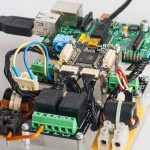 During last weeks, some local building contractor was involved in reconstruction of our house and renewing the basement drainage. As a result the new basement drainage has been installed and a new hopper for the sewage pumps has been placed. To be honest, it is a lot of heavy work, performed by the builder including digging, insulating, pounding and other dirty staff – but after all the system works if sewage pump is removing the drainage water. In constrast to the earthworks, where you need much experience and human force, which I don’t have, I took over the plumbing and electrical work on the pumps. In order to have a fail-over system, I installed two pumps, where the second pump is triggered if the first one fails. In order to be able to operate on a short circuit of the first pump, I put the second pump on a separate phase (in Europe, we have three phases power supply, 220V each, shifted by 120° to each other, not like split-phase in US). Having this system installed, you get some periodic work to do: finally you want to make sure by regular testing procedures, that the second pump is operating if the first one has failed. Since I’m lazy and like inventing and constucting stuff more than executing regular test procedures, I decided to implement a monitoring system using some cheap electronic and computer components: Raspberry Pi, Tinkerforge Hardware.
During last weeks, some local building contractor was involved in reconstruction of our house and renewing the basement drainage. As a result the new basement drainage has been installed and a new hopper for the sewage pumps has been placed. To be honest, it is a lot of heavy work, performed by the builder including digging, insulating, pounding and other dirty staff – but after all the system works if sewage pump is removing the drainage water. In constrast to the earthworks, where you need much experience and human force, which I don’t have, I took over the plumbing and electrical work on the pumps. In order to have a fail-over system, I installed two pumps, where the second pump is triggered if the first one fails. In order to be able to operate on a short circuit of the first pump, I put the second pump on a separate phase (in Europe, we have three phases power supply, 220V each, shifted by 120° to each other, not like split-phase in US). Having this system installed, you get some periodic work to do: finally you want to make sure by regular testing procedures, that the second pump is operating if the first one has failed. Since I’m lazy and like inventing and constucting stuff more than executing regular test procedures, I decided to implement a monitoring system using some cheap electronic and computer components: Raspberry Pi, Tinkerforge Hardware.
Read more about it on TechJava.
If you are interested in IoT subject or on other hardware hacking stuff, you can read the coresponding IoT category.






